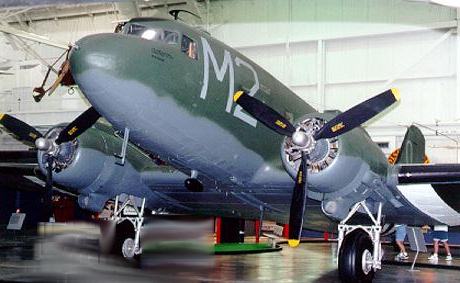

D-DAY THE AIRBORNE ASSAULT
 |
While Task Force U was still approaching the Transport Area, the first blows had already struck the enemy from the air. The intensive air bombardment of the invasion area had started about midnight, 5 June. At that time RAF bombers made intensive attacks on the known enemy batteries along the entire invasion coast. Shortly before H Hour medium bombers of the Ninth Air Force dropped several hundred tons of bombs on enemy defenses at Utah Beach in support of the seaborne assault. Between these bombings, however, came the still more telling attacks by airborne infantry. It was the largest use of airborne troops up to that time. Paratroop elements of the 82d and 101st Divisions, comprising 6 regiments, with the normal complement of parachute field artillery and engineers, numbering more than 13,000 men, were flown from bases in southern England to the Cotentin Peninsula in approximately 925 C-47's. An additional 4,000 men, consisting of glider infantry with supporting weapons and medical and signal units, were to arrive in 500 gliders later on D Day and on D plus 1 to reinforce the paratroops. |
Seaborne echelons were to join the divisions on D plus 1. To the parachute troops was assigned what was probably the most difficult task of the initial operation-a night jump behind enemy lines five hours before the coastal landings. The 101st Airborne Division Lands At 2215 on D minus 1, 432 C-47's began taking off from 7 departure airdromes in England, with 6,600 paratroops of the 101st Airborne Division. They were scheduled to begin dropping at H minus s hours. At dawn (H minus 2 hours) they were to be reinforced by approximately 150 glider troops from 51 gliders, and at dusk (H plus 15 hours) by an additional 165 in 32 gliders. Preceding the main echelons of paratroops by half an hour were 20 pathfinder aircraft which had the mission of marking six drop zones (for both divisions) and one landing zone. Marking of the zones was not entirely successful, but all of the pathfinder teams carried out at least part of their missions. Paratroop echelons approached the Cotentin from the west and made their landfall in the vicinity of les Pieux (Map No. 2). Formations were tight until reaching the coast, but from the coast to the Merderet cloud banks loosened the formations, and east of the Merderet flak scattered them further. In general the division did not have a good drop, although better than that of the 82d Airborne Division (Map V). About 1,500 troops were either killed or captured and approximately 60 percent of the equipment dropped was lost when the bundles fell into swamps or into fields covered by enemy fire. Only a fraction of the division's organized strength could ininially be employed on the planned missions, and many of the missions carried out were undertaken by mixed groups which did not correspond with original assignments.
| ŠAvStop Online Magazine Contact Us Return To News |